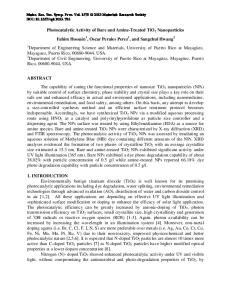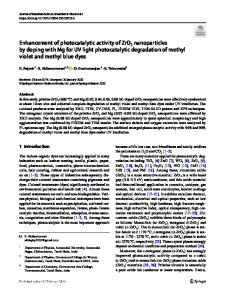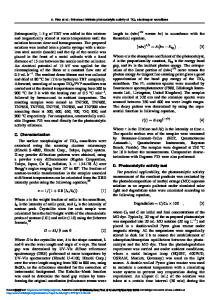Influence of iron doping on the photocatalytic activity of nanocrystalline TiO 2 particles fabricated by ultrasound meth
- PDF / 3,381,825 Bytes
- 13 Pages / 595.276 x 790.866 pts Page_size
- 2 Downloads / 339 Views
Influence of iron doping on the photocatalytic activity of nanocrystalline TiO2 particles fabricated by ultrasound method for enhanced degradation of organic dye Mohamed Saber Lassoued1,2,3 · Abdelmajid Lassoued1 · Mohammed S. M. Abdelbaky3 · Salah Ammar1 · Abdellatif Gadri1 · Abdelhamid Ben Salah2 · Santiago García‑Granda3 Received: 4 December 2017 / Accepted: 10 January 2018 / Published online: 17 January 2018 © Springer Science+Business Media, LLC, part of Springer Nature 2018
Abstract Synthesis and characterization of Fe doped T iO2 composite with iron concentration varying from 0 to 7% as a photocatalyst in the photodegradation of methylene orange on UV–Vis light irradiation in a closed reactor has been carried out. Synthesis was conducted by the ultrasound method at room temperature using tetrabutyl titanate and iron(III)chloride 6-hydrate as a precursor, followed by thermal treatment at a temperature of 600 °C. The characterizations were performed using X-ray diffraction (XRD), transmission electron microscopy, scanning electron microscopy (SEM), FT-IR spectrometry, thermal analysis, UV–Vis diffuse reflectance spectrophotometer, photoluminescence and Brunauer–Emmett–Teller (BET). XRD spectra revealed that samples crystallized in the anatase phase at 600 °C. The transmission and SEM were used to detect the morphology of synthesized nanoparticles, which sizes changed with the altitude in the doping concentration to 7%. FTIR spectra exhibit broad peaks where anatase phases of T iO2 demonstrate very sharp peaks. In accordance with UV–Vis absorption measurements, this diminution of nanoparticles sizes was followed by a decrease in the band gap value from 3.21 eV, for undoped TiO2, to 2.46 eV, for TiO2 doped at 7%. The TGA showed three mass losses, whereas DTA resulted in three endothermic peaks. The maximum photoconversion efficiency was 2.5%, which was six times the photoconversion efficiency of undoped T iO2. Finally, the prepared materials were used to photocatalyse the decolourization of methylene orange in aqueous medium as a model compound under the illumination of visible light (λ = 420 nm).
1 Introduction Over the last few decades, much consideration has been given to a number of nanostructured metal oxide semiconductors which have been studied owing to their interesting physical properties including non-linear optical activity, photoluminescence (PL) and electrical properties [1–6] and their potential applications in various fields, such as * Mohamed Saber Lassoued [email protected] 1
Unité de Recherché Electrochimie, Matériaux et Environnement UREME (UR17ES45), Faculté des Sciences de Gabès, Université de Gabès, Cité Erriadh, 6072 Gabès, Tunisia
2
Material and Environment Science Laboratory, Science Faculty of Sfax University, Post Box 1171, 3000 Sfax, Tunisia
3
Department of Physical and Analytical Chemistry, Oviedo University-CINN, 33006 Oviedo, Spain
photocatalysis to decompose undesirable organic matters [7–9], optical coating, solar cells [10, 11], filters for catalys
Data Loading...











